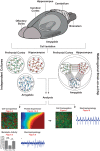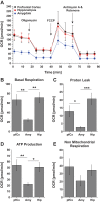Neurons derived from different brain regions are inherently different in vitro: a novel multiregional brain-on-a-chip
- PMID: 28031399
- PMCID: PMC5350271
- DOI: 10.1152/jn.00575.2016
Neurons derived from different brain regions are inherently different in vitro: a novel multiregional brain-on-a-chip
Abstract
Brain in vitro models are critically important to developing our understanding of basic nervous system cellular physiology, potential neurotoxic effects of chemicals, and specific cellular mechanisms of many disease states. In this study, we sought to address key shortcomings of current brain in vitro models: the scarcity of comparative data for cells originating from distinct brain regions and the lack of multiregional brain in vitro models. We demonstrated that rat neurons from different brain regions exhibit unique profiles regarding their cell composition, protein expression, metabolism, and electrical activity in vitro. In vivo, the brain is unique in its structural and functional organization, and the interactions and communication between different brain areas are essential components of proper brain function. This fact and the observation that neurons from different areas of the brain exhibit unique behaviors in vitro underline the importance of establishing multiregional brain in vitro models. Therefore, we here developed a multiregional brain-on-a-chip and observed a reduction of overall firing activity, as well as altered amounts of astrocytes and specific neuronal cell types compared with separately cultured neurons. Furthermore, this multiregional model was used to study the effects of phencyclidine, a drug known to induce schizophrenia-like symptoms in vivo, on individual brain areas separately while monitoring downstream effects on interconnected regions. Overall, this work provides a comparison of cells from different brain regions in vitro and introduces a multiregional brain-on-a-chip that enables the development of unique disease models incorporating essential in vivo features.NEW & NOTEWORTHY Due to the scarcity of comparative data for cells from different brain regions in vitro, we demonstrated that neurons isolated from distinct brain areas exhibit unique behaviors in vitro. Moreover, in vivo proper brain function is dependent on the connection and communication of several brain regions, underlining the importance of developing multiregional brain in vitro models. We introduced a novel brain-on-a-chip model, implementing essential in vivo features, such as different brain areas and their functional connections.
Keywords: brain-on-a-chip; different brain regions; electrophysiology; metabolism; protein expression.
Copyright © 2017 the American Physiological Society.
Figures











Similar articles
-
Adult neural progenitor cells reactivate superbursting in mature neural networks.Exp Neurol. 2012 Mar;234(1):20-30. doi: 10.1016/j.expneurol.2011.12.009. Epub 2011 Dec 14. Exp Neurol. 2012. PMID: 22198136
-
Glutamatergic nonpyramidal neurons from neocortical layer VI and their comparison with pyramidal and spiny stellate neurons.J Neurophysiol. 2009 Feb;101(2):641-54. doi: 10.1152/jn.91094.2008. Epub 2008 Dec 3. J Neurophysiol. 2009. PMID: 19052106 Free PMC article.
-
Phencyclidine affects firing activity of ventral tegmental area neurons that are related to reward and social behaviors in rats.Neuroscience. 2013 Jun 14;240:336-48. doi: 10.1016/j.neuroscience.2013.02.047. Epub 2013 Mar 1. Neuroscience. 2013. PMID: 23458711
-
Glutamate receptor antibodies in neurological diseases: anti-AMPA-GluR3 antibodies, anti-NMDA-NR1 antibodies, anti-NMDA-NR2A/B antibodies, anti-mGluR1 antibodies or anti-mGluR5 antibodies are present in subpopulations of patients with either: epilepsy, encephalitis, cerebellar ataxia, systemic lupus erythematosus (SLE) and neuropsychiatric SLE, Sjogren's syndrome, schizophrenia, mania or stroke. These autoimmune anti-glutamate receptor antibodies can bind neurons in few brain regions, activate glutamate receptors, decrease glutamate receptor's expression, impair glutamate-induced signaling and function, activate blood brain barrier endothelial cells, kill neurons, damage the brain, induce behavioral/psychiatric/cognitive abnormalities and ataxia in animal models, and can be removed or silenced in some patients by immunotherapy.J Neural Transm (Vienna). 2014 Aug;121(8):1029-75. doi: 10.1007/s00702-014-1193-3. Epub 2014 Aug 1. J Neural Transm (Vienna). 2014. PMID: 25081016 Review.
-
Engineering microsystems to recapitulate brain physiology on a chip.Drug Discov Today. 2019 Sep;24(9):1725-1730. doi: 10.1016/j.drudis.2019.06.008. Epub 2019 Jun 18. Drug Discov Today. 2019. PMID: 31226433 Review.
Cited by
-
Expanding sacrificially printed microfluidic channel-embedded paper devices for construction of volumetric tissue models in vitro.Biofabrication. 2020 Sep 18;12(4):045027. doi: 10.1088/1758-5090/abb11e. Biofabrication. 2020. PMID: 32945271 Free PMC article.
-
Electrophysiological Activity of Primary Cortical Neuron-Glia Mixed Cultures.Cells. 2023 Mar 6;12(5):821. doi: 10.3390/cells12050821. Cells. 2023. PMID: 36899957 Free PMC article.
-
Battling Neurodegenerative Diseases with Adeno-Associated Virus-Based Approaches.Viruses. 2020 Apr 18;12(4):460. doi: 10.3390/v12040460. Viruses. 2020. PMID: 32325732 Free PMC article. Review.
-
Tissue-specific extracellular matrix accelerates the formation of neural networks and communities in a neuron-glia co-culture on a multi-electrode array.Sci Rep. 2019 Mar 11;9(1):4159. doi: 10.1038/s41598-019-40128-1. Sci Rep. 2019. PMID: 30858401 Free PMC article.
-
Rich dynamics and functional organization on topographically designed neuronal networks in vitro.iScience. 2022 Nov 26;25(12):105680. doi: 10.1016/j.isci.2022.105680. eCollection 2022 Dec 22. iScience. 2022. PMID: 36567712 Free PMC article.
References
Publication types
MeSH terms
Substances
Grants and funding
LinkOut - more resources
Full Text Sources
Other Literature Sources

